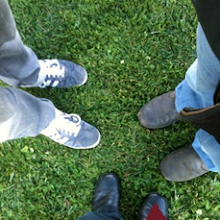Aadrvark

~~~~~~~~~~~~~~~~~~~~~~~~~~~~~~~~~~
The name aardvark comes from a word meaning "earth pig." Although the aardvark, endemic to Africa, shares some similarities with the South American anteater, the two are not related. The last survivor of a group of primitive ungulates.(what's an ungulate?)(animals with hoofs, like a horse!)
The aardvark has a short neck connected to a massive, almost hairless body with a strongly arched back. The aardvark has poor eyesight, it's legs are short, the head is elongated, with a long, narrow snout and nostrils that can be sealed. The long, tubular ears are normally held upright but can be folded and closed. The short but muscular tail tapers to a point. As it is nocturnal. The thick claws on the forefeet are well adapted for digging.
Aardvarks are found in all regions, from dry savanna to rain forest, where there are sufficient termites for food, access to water and sandy or clay soil. They are mostly solitary and nocturnal, but sometimes will come out during the day to sun themselves. They may dig themselves new burrows nightly.
The aardvark is cautious upon leaving its burrow sitting motionless for several minutes then suddenly leaping out in powerful jumps. When pursued, an aardvark will furiously dig itself a hole, and when attacked, may roll onto its back and defend itself with its large claws or use its thick tail to somersault away from its attackers.


Aardvarks give birth to one offspring at a time. At about 6 months the young male becomes independent while the young female stays with the mother until after the next baby is born. The young female digs its own burrow a few yards and joins her to forage for termites.
They move from one termite mound to another, dismantling the hills with their powerful claws. Insects are trapped by the aardvark's long protractile tongue (as long as 30 cm), which is covered with a thick, sticky saliva. Sometimes the aardvark will press its snout against an opening in a mound and suck up the termites. Aardvarks, with their keen sense of smell, also hunt for the long columns of termites that move outside the mounds at night.
~~~~~~~~~~~~~~~~~~~~~~~~~~~~~~~~~~~
Giant Anteater.
The anteater is the largest of the South American anteaters and can be found in the grasslands and rainforests of the northern half of South America. They have long, tube-shaped heads and an extremely long worm-like tongue. They have course, stiff hair that is longest at the tail.
The Giant Anteater primarily feeds on ants and termites (they've also been known to eat beetle larvae and fruit); using its strong, six inch claws to tear open rotten logs, large anthills and termite nests. It's long, sticky tongue then licks up the eggs, cocoons and adult insects. These creatures may consume up to 35,000 insects a day. The gestation period for the Giant Anteater is about 190 days and the single baby weighs about 2 1/2 pounds at birth. The young nurse for approximately three months, never leaving the mother, who carries the baby on her back for the first 6-9 months of it's life.


Giant Anteaters are found in a variety of habitats, from the rainforest to the savannahs. They may also be active both during the day and at night. This species of anteater is peculiar: though they are solitary creatures, they are nonterritorial. And though they do not have the ability to climb like the other smaller two species of anteater, they are excellent swimmers.
...

No comments:
Post a Comment